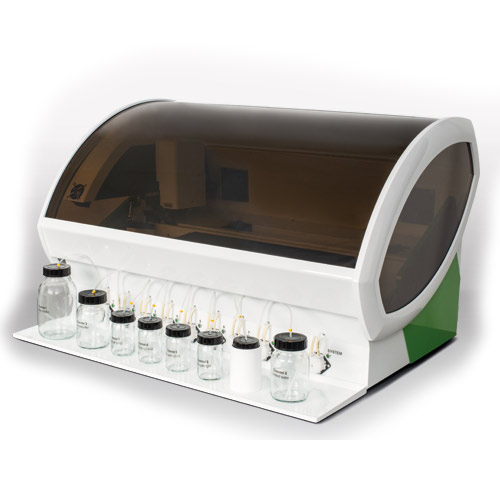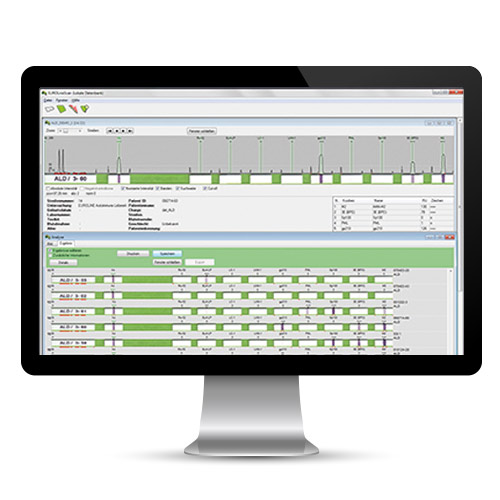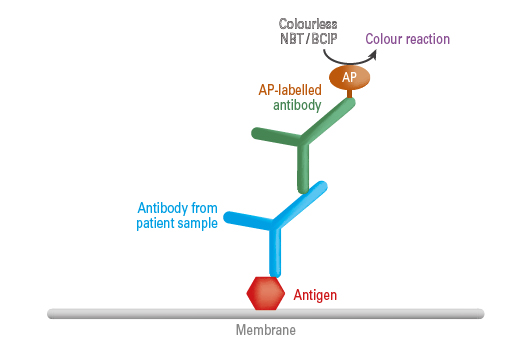 In the immunoblot, antigens coated on membranes are used as a solid phase in order to detect specific antibodies. The test performance is either manual, semi- or fully automated. If a sample contains specific antibodies, these bind to the membrane-bound antigens. In the next step, an alkaline phosphatase (AP) labelled antibody (conjugate) is added, which binds to the specific antibodies. The alkaline phosphatase catalyses a color reaction with the subsequently added nitro blue tetrazolium chloride/5-bromo-4-chloro-3-indolyl phosphate (NBT/BCIP). If specific antibodies are present, a dark line appears at the respective antigen position. The intensity of the resulting staining is proportional to the antibody concentration in the sample.
In the immunoblot, antigens coated on membranes are used as a solid phase in order to detect specific antibodies. The test performance is either manual, semi- or fully automated. If a sample contains specific antibodies, these bind to the membrane-bound antigens. In the next step, an alkaline phosphatase (AP) labelled antibody (conjugate) is added, which binds to the specific antibodies. The alkaline phosphatase catalyses a color reaction with the subsequently added nitro blue tetrazolium chloride/5-bromo-4-chloro-3-indolyl phosphate (NBT/BCIP). If specific antibodies are present, a dark line appears at the respective antigen position. The intensity of the resulting staining is proportional to the antibody concentration in the sample.
EUROLINE
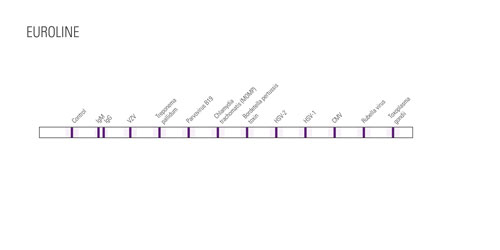 EUROLINE assays are multiparameter line blots which enable generation of comprehensive combined antibody profiles on one test strip. Membrane strips with multiple purified, biochemically characterized antigens or antigen extracts as thin parallel lines are used as the antigen-containing solid phase. The membranes are fixed as chips at exactly defined positions on plastic foils. The membrane strips do not contain superfluous proteins which may lead to unspecific results. On every EUROLINE test strip, there is a control band which indicates whether the individual incubation steps have been performed correctly.
EUROLINE assays are multiparameter line blots which enable generation of comprehensive combined antibody profiles on one test strip. Membrane strips with multiple purified, biochemically characterized antigens or antigen extracts as thin parallel lines are used as the antigen-containing solid phase. The membranes are fixed as chips at exactly defined positions on plastic foils. The membrane strips do not contain superfluous proteins which may lead to unspecific results. On every EUROLINE test strip, there is a control band which indicates whether the individual incubation steps have been performed correctly.
Westernblot and EUROLINE-WB
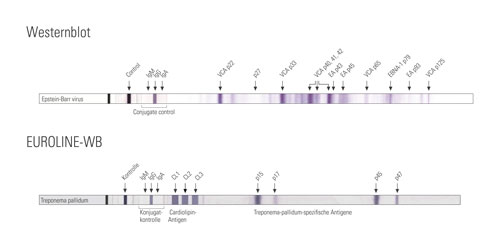 The Western blot strips are used as antigen-containing solid phase. They are coated with antigen extracts electrophoretically separated according to molecular mass.
The Western blot strips are used as antigen-containing solid phase. They are coated with antigen extracts electrophoretically separated according to molecular mass.
EUROLINE-WB assays are a combination of Western blot and EUROLINE tests: The Western blot strips are additionally coated with highly purified native or recombinant antigens in the form of membrane chips. The correct performance of the individual incubation steps is indicated by the staining of the control band at the lower end of each strip.
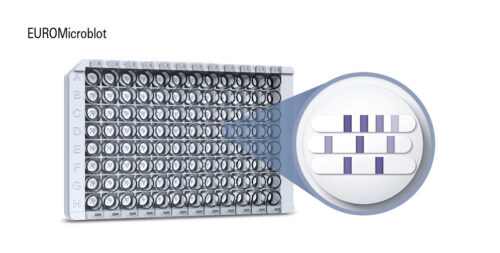 EUROMicroblots
EUROMicroblots
EUROMicroblots are miniaturized multiparameter line blots in microplate format. The microplate wells contain test strips printed with purified antigens and controls at defined positions. The break-off wells can be separated individually so that the number of analyses can be flexibly adapted to the actual need. By providing the immunoblot in a microplate format, assays can be processed on one automated ELISA system and free capacities on the instrument can be used optimally.
